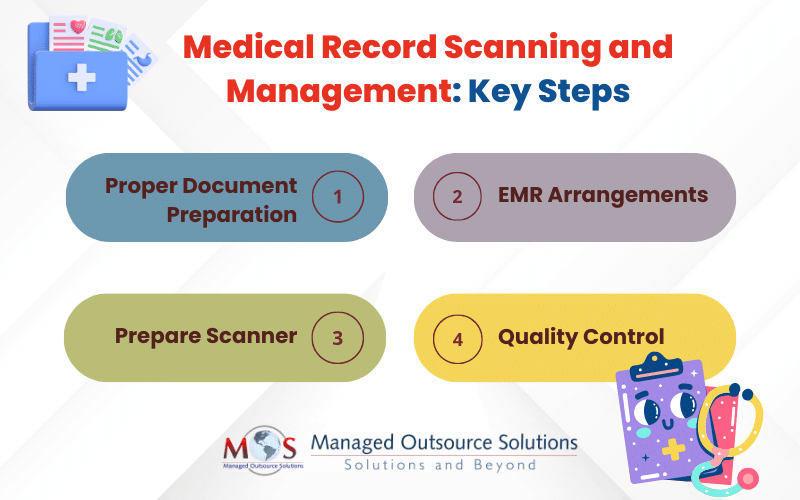Managing huge volume of patient records in any healthcare practice is quite challenging. Key challenges practices face include complying with HIPAA regulatory requirements, ensuring accuracy of data, maintaining privacy of patients, and organizing information the right way. With medical records digitization, healthcare providers can store, manage, and access patient information more efficiently. Professional medical document scanning services can help healthcare providers to simplify their operations, improve patient care, and enhance data security.
Digitization of medical documents is beneficial because –
- you can have all your paper charts embedded into your EMR system.
- this saves you the manual labor of pulling out the charts the day before you see patients.
- patient data becomes accessible via your EMR system to the entire caregiving team.
- you can even review patient charts from home, office or from a mobile device.
Paper copies of these records can also take up valuable space, and it can be frustrating for doctors to sift through the pile of lab results. It can also lead to patient dissatisfaction. A proper medical record scanning process can prevent potential problems and ensure compliance. It also ensures quick retrieval and safe storage of critical patient data. Make sure that you have all the necessary security measures in place to safeguard sensitive health information.
Medical Document Scanning and Management Tips
Here are some basic steps described in detail that you can follow for accurate scanning and management of medical records:
- Proper document preparation: Keep count of all medical files in your batch and count the number of pages in each file. Take out all the staples from all the pages and ensure that each and every page has a clear and straight edge. If required, cut out the jagged edge and tape down any post-it notes to fresh paper. This will help in clear scanning of all records.Make sure that you face all pages the same way, and use a jogger for properly aligning the pages for the scanner. Fanning the pages once before loading the paper will help prevent double feeding errors.
- EMR arrangements: Have four index fields in each medical record, with at least one unique field – for instance, last name, first name, DOB and Unique Health Number. This information is available for match-and-merge from data extracted from your EMR or billing software.
- Prepare scanner: Set your device to 300 dpi to ensure accuracy. Also, check the clearness of the scanned documents. You can either manually enter the details or use the Match and Merge option. Scan each and every file individually and name them according to your conventions, and also keep a backup of all important documents.
- Quality control: Proofread the scanned documents. Implement rigorous quality control measures to ensure accurate scanning, including double-checking the scanned documents for legibility and completeness. A quality analyst can check the quality of the documents and review samples for any issues. Count the total number of digital files you have saved and ensure that this number matches the total number of files in your batch. It is important to check each digitized file to make sure that the number of pages match.
Follow these best practices to continuously evaluate and improve scanning and management processes. Enhance efficiency, accuracy, and compliance with evolving standards and technologies.
Google’s “Project Nightingale”
Google has teamed up with one of the U.S’ largest healthcare systems on a project to collect and crunch the detailed personal health information of millions of people across 21 states. This project is said to be the biggest effort to gain a toehold in the healthcare industry through the handling of patients’ medical data. It was started in secret last year with St. Louis-based Ascension, a Catholic chain of 2,600 hospitals, doctors’ offices and other facilities, with the data sharing accelerating since summer, according to internal documents. The data involved in the initiative includes lab results, doctor diagnoses and hospitalization records among other categories, and amounts to a complete health history, including patient names and dates of birth. Google has teamed up with Ascension to crunch patient data for treatment and administrative purposes. When a patient checks into the office, the nurse or doctor examines the patient and enters data into the computers. This data instantly flows to Google’s ‘Project Nightingale’ and the system suggests outcomes like treatment plan, replacement or addition of doctors to the patient’s team, additional enforcement of narcotics policies and so on. Around 150 Google employees already have access to much of the data on tens of millions of patients. News released after the Wall Street Journal report stated that this initiative is compliant with federal health law and includes robust protections for patient data. Although there have been questions about data collection and sharing, it is permissible under the Healthcare Insurance Portability and Accountability Act of 1996.
Google Cloud President Tariq Shaukat said the company’s goal for healthcare is centered on “ultimately improving outcomes, reducing costs, and saving lives. Ascension, the second-largest health system in the U.S., aims to improve patient care. It also hopes to mine data to identify additional tests that could be necessary or other ways in which the system could generate more revenue from patients.
Google appears to share information within Project Nightingale more broadly than in its other forays into healthcare data. In September, Google announced a 10-year deal with the Mayo Clinic to store the hospital system’s genetic, medical and financial records. Mayo officials had assured that any data used to develop new software would be wiped clean of personally identifiable patient information before it is shared with Google.
Project Nightingale appears to align with the learning health system concept and systematically improve healthcare. It also improves understanding of what treatments are effective and safe for these underrepresented populations.
Switching from paper-based documents to electronic mode can be a difficult task but outsourcing to a reliable provider of document scanning services helps to speed up the process of digitization with utmost accuracy and high quality.
Reduce paper clutter with our reliable medical record scanning services.





